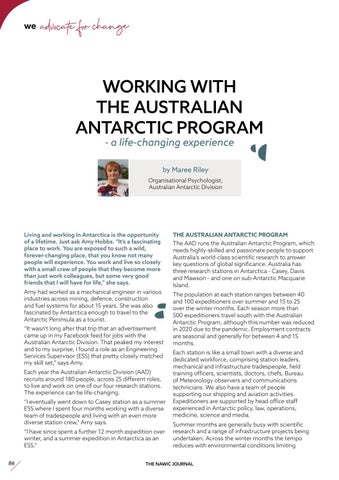we
advocate for change
WORKING WITH THE AUSTRALIAN ANTARCTIC PROGRAM - a life-changing experience by Maree Riley Organisational Psychologist, Australian Antarctic Division
Living and working in Antarctica is the opportunity of a lifetime. Just ask Amy Hobbs. “It’s a fascinating place to work. You are exposed to such a wild, forever-changing place, that you know not many people will experience. You work and live so closely with a small crew of people that they become more than just work colleagues, but some very good friends that I will have for life,” she says.
THE AUSTRALIAN ANTARCTIC PROGRAM
Amy had worked as a mechanical engineer in various industries across mining, defence, construction and fuel systems for about 15 years. She was also fascinated by Antarctica enough to travel to the Antarctic Peninsula as a tourist.
The population at each station ranges between 40 and 100 expeditioners over summer and 15 to 25 over the winter months. Each season more than 500 expeditioners travel south with the Australian Antarctic Program, although this number was reduced in 2020 due to the pandemic. Employment contracts are seasonal and generally for between 4 and 15 months.
“It wasn’t long after that trip that an advertisement came up in my Facebook feed for jobs with the Australian Antarctic Division. That peaked my interest and to my surprise, I found a role as an Engineering Services Supervisor (ESS) that pretty closely matched my skill set,” says Amy. Each year the Australian Antarctic Division (AAD) recruits around 180 people, across 25 different roles, to live and work on one of our four research stations. The experience can be life-changing. “I eventually went down to Casey station as a summer ESS where I spent four months working with a diverse team of tradespeople and living with an even more diverse station crew,” Amy says. “I have since spent a further 12 month expedition over winter, and a summer expedition in Antarctica as an ESS.” 86
The AAD runs the Australian Antarctic Program, which needs highly-skilled and passionate people to support Australia’s world-class scientific research to answer key questions of global significance. Australia has three research stations in Antarctica - Casey, Davis and Mawson - and one on sub-Antarctic Macquarie Island.
Each station is like a small town with a diverse and dedicated workforce, comprising station leaders, mechanical and infrastructure tradespeople, field training officers, scientists, doctors, chefs, Bureau of Meteorology observers and communications technicians. We also have a team of people supporting our shipping and aviation activities. Expeditioners are supported by head office staff experienced in Antarctic policy, law, operations, medicine, science and media. Summer months are generally busy with scientific research and a range of infrastructure projects being undertaken. Across the winter months the tempo reduces with environmental conditions limiting
THE NAWIC JOURNAL





































